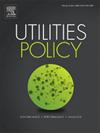优化燃煤发电机组战略储备,平衡中国清洁能源转型的可靠性和成本
IF 4.4
3区 经济学
Q3 ENERGY & FUELS
引用次数: 0
摘要
火电机组战略储备机制为解决电力系统低碳转型中的安全问题提供了一个可行的政策选择。本文提出了一种结合蒙特卡罗模拟和混合整数线性规划的战略储备选择框架,通过最小化未服务的单位成本降低来确定最优储备单元,从而量化300 MW、600 MW和1000 MW等不同容量、服务年限为1 ~ 30年的机组转换为战略储备的经济效率。对华东地区某代表性地区的模拟结果表明,将1000mw机组转换为20年左右的服役年限,经济效益最佳。在可再生能源渗透率达到30%的情况下,1000兆瓦机组的最低战略储备成本为13780元/兆瓦时,而600兆瓦和300兆瓦机组的最低战略储备成本分别为15630元和26120元/兆瓦时。当渗透率提高到50%时,1000mw、600mw和300mw机组的最低成本分别降低80.19%、77.42%和76.03%。敏感性分析表明,储量边际的增加增加了成本,而可再生能源渗透率的增加则提前了最佳转换年龄。大容量机组一贯提供卓越的减少预期能源不服务,高达64.65%的可靠性提高。这些发现为依赖煤炭的国家的政策制定者提供了经验指导,突出了优先考虑大型、中等老化机组进行储备转换以平衡可靠性和经济目标的成本效益。本文章由计算机程序翻译,如有差异,请以英文原文为准。
Optimizing the strategic reserves of coal-fired power units to balance reliability and cost in China's clean energy transition
The strategic reserve mechanism for coal-fired power units provides a viable policy option to address security concerns in the low-carbon transition of the power system. This paper proposes a strategic reserve selection framework combining Monte Carlo simulation and mixed-integer linear programming to identify optimal reserve units by minimizing the cost per unit reduction in expected energy not served, thereby quantifying the economic efficiency of converting units of different capacities such as 300 MW, 600 MW, and 1000 MW and with service ages ranging from 1 to 30 years into strategic reserves. Simulation results for a representative region in East China indicate that converting 1000 MW units at around 20 years of service age yields the best economic benefits. With a renewable penetration rate of 30 %, the minimum strategic reserve cost of a 1000 MW unit is 13,780 CNY/MWh, compared to 15,630 and 26,120 CNY/MWh for 600 MW and 300 MW units, respectively. When the penetration rate increases to 50 %, the minimum cost of 1000 MW, 600 MW, and 300 MW units is reduced by 80.19 %, 77.42 %, and 76.03 %, respectively. Sensitivity analysis shows that increasing reserve margin raises costs, while higher renewable penetration advances the optimal conversion age. Large-capacity units consistently offer superior reduction of expected energy not served, with up to 64.65 % reliability improvement. These findings provide empirical guidance for policymakers in coal-dependent countries, highlighting the cost-effectiveness of prioritizing large, moderately aged units for reserve conversion to balance reliability and economic objectives.
求助全文
通过发布文献求助,成功后即可免费获取论文全文。
去求助
来源期刊

Utilities Policy
ENERGY & FUELS-ENVIRONMENTAL SCIENCES
CiteScore
6.80
自引率
10.00%
发文量
94
审稿时长
66 days
期刊介绍:
Utilities Policy is deliberately international, interdisciplinary, and intersectoral. Articles address utility trends and issues in both developed and developing economies. Authors and reviewers come from various disciplines, including economics, political science, sociology, law, finance, accounting, management, and engineering. Areas of focus include the utility and network industries providing essential electricity, natural gas, water and wastewater, solid waste, communications, broadband, postal, and public transportation services.
Utilities Policy invites submissions that apply various quantitative and qualitative methods. Contributions are welcome from both established and emerging scholars as well as accomplished practitioners. Interdisciplinary, comparative, and applied works are encouraged. Submissions to the journal should have a clear focus on governance, performance, and/or analysis of public utilities with an aim toward informing the policymaking process and providing recommendations as appropriate. Relevant topics and issues include but are not limited to industry structures and ownership, market design and dynamics, economic development, resource planning, system modeling, accounting and finance, infrastructure investment, supply and demand efficiency, strategic management and productivity, network operations and integration, supply chains, adaptation and flexibility, service-quality standards, benchmarking and metrics, benefit-cost analysis, behavior and incentives, pricing and demand response, economic and environmental regulation, regulatory performance and impact, restructuring and deregulation, and policy institutions.
 求助内容:
求助内容: 应助结果提醒方式:
应助结果提醒方式:


